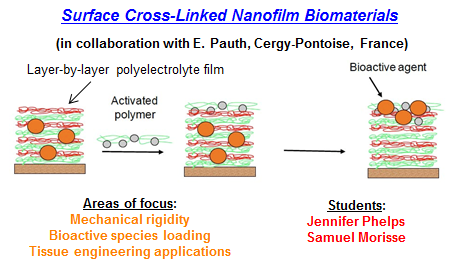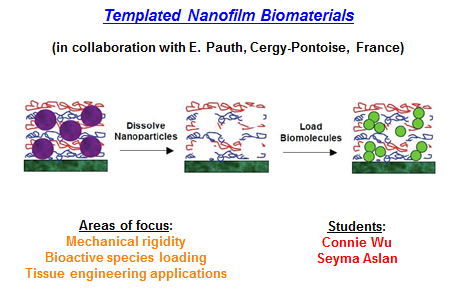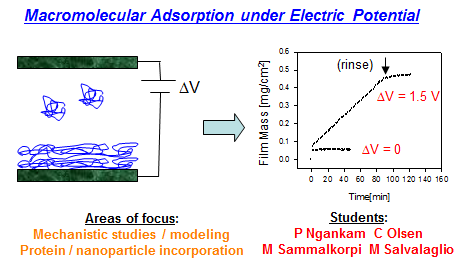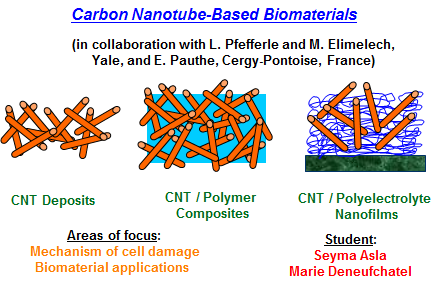Nanofilm biomaterials
Thin film biomaterials of nanoscale thickness offer exciting possibilities in tissue engineering and drug/gene delivery. The Van Tassel group at Yale employs layer-by-layer assembly of oppositely charged macromolecules to construct nanofilm biomaterials for cell contacting applications. The focus is on the way in which film chemical structure, mechanical rigidity, and bioactive species loading together influence the response of contacting cells. Ideal materials are i) loaded with a high concentration of bioactive species, to elicit a controlled biological response, and ii) of high mechanical rigidity, to promote robust cell adhesion. A key challenge is that most common approaches toward increasing mechanical rigidity (e.g. chemical cross-linking) tend to suppress bioactive species accessibility. We address this challenge through two strategies, 1) confining chemical cross-linking to the film’s outer skin, so cells experience a rigid substrate but bioactive species are not compromised, and 2) nanoparticle templating, where removal following film cross-linking creates pore space accessible to bioactive species, without sacrificing mechanical rigidity. Applications of both strategies toward tissue engineering – where one seeks to create functioning tissue by implanting cells housed within a biomaterial scaffold – are being pursued.


Macromolecular adsorption under electric potential
Controlling the structure of macromolecular adsorbed layers is a significant challenge, yet crucial to many material and sensing applications. The Van Tassel group at Yale employs external electric fields to engineer structurally tailored protein and polyelectrolyte layers / films. A most interesting discovery is adsorption that can become essentially continuous – i.e. thickness scaling roughly linearly with time over hours. Our combined experimental and theoretical efforts suggest a mechanism involving charge regulation and suppressed electrostatic repulsion at the electrified interface, leading to polymer-polymer binding (in apparent violation of electrostatics!). This finding suggests the exciting possibility of single component polyelectrolyte nanofilms of tailored thickness realized in a single step.

Carbon nanotube-based biomaterials
Carbon nanotubes (CNT) are widely considered to be a “material of the future” owing to their unique optical, electrical, and mechanical properties. CNT also possess certain characteristics ideal for biomedical applications: exceptional mechanical strength, high surface area, ease of chemical functionalization, and inherent anti-microbial properties. Many biomedical applications are best met with biomaterials of multiple functions, and owing to the above-listed attributes, CNT are especially promising in this regard. In particular, CNT are known to perform the following three important, and rather diverse, functions: support cell adhesion and viability, deliver genetic material through the cell membrane, and suppress microbial contamination. The Van Tassel group at Yale is developing thin film and gel materials containing CNT as multi-functional biomaterials.
